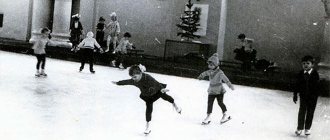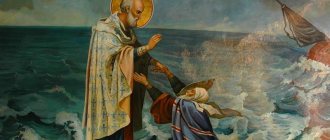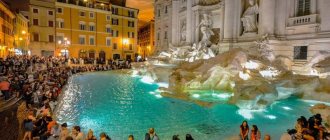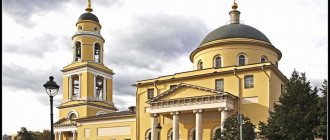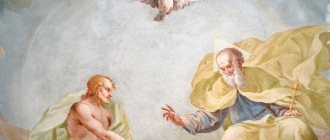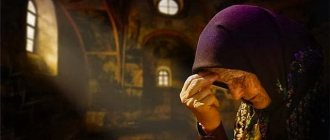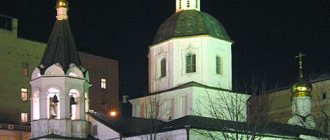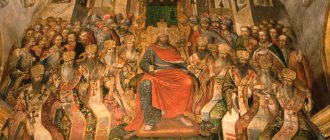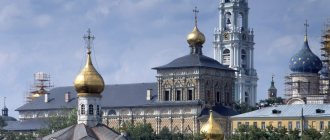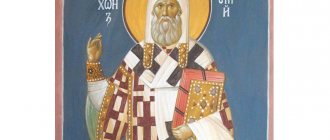"Save me, God!".
Thank you for visiting our website, before you start studying the information, please subscribe to our Orthodox community on Instagram, Lord, Save and Preserve † - https://www.instagram.com/spasi.gospodi/. The community has more than 60,000 subscribers. There are many of us like-minded people and we are growing quickly, we post prayers, sayings of saints, prayer requests, and timely post useful information about holidays and Orthodox events... Subscribe. Guardian Angel to you!
Moscow saints Peter, Jonah, Philip, Alexy were metropolitans at different times, but during difficult periods for Russia. They took care of their flock, built churches and monasteries, and contributed to the spread of the Orthodox faith.
Venerable Sergius of Radonezh: a true monk
One of the greatest saints of Orthodoxy, “abbot of the Russian land,” St. Sergius (1322(?)-1392) became famous for his many spiritual exploits and works. Since childhood, he devoted more time to prayer than to games and fun. At the age of twenty, after the death of his parents, Sergius (then still Bartholomew), gives away all his property and goes with his brother Stefan to the deep forests of Radonezh. Having found a suitable place, Sergius builds a cell and a church and begins his monastic service (he took monastic vows in 1342). Over the following years, the small cell grew into a large monastery, and Sergius himself gained fame as a great ascetic, prayer book, and hardworking monk. Knowing the spiritual experience and exploits of St. Sergius, not only peasants, but also Moscow clergy, boyars, and princes constantly came to him for advice. It is known that during his lifetime the saint became famous for his gift of miracles.
With the blessing of Saint Sergius, many monasteries were founded, and he himself, in his monastery (Holy Trinity), raised a whole generation of students who later continued the work of their mentor. Another evidence of respect for Saint Sergius was the visit of Prince Dimitry Donskoy to him for a blessing before the Battle of Kulikovo in 1380. The Monk Sergius perspicaciously predicted the victory of the Russian armies over the Tatar-Mongols.
Saint Sergius of Radonezh also became famous for his ability to reconcile the often warring Russian princes; he was the confessor of Demetrius Donskoy, a real educator and mentor not only for monks, but also for many ordinary people. The monastery he founded, the Holy Trinity Lavra of St. Sergius, became an ever-living memory of him.
Prince Daniel. City Builder
In the year of the death of Grand Duke Alexander Nevsky, the youngest of his sons, Daniil, was two years old. He inherited the smallest inheritance: the unknown town of Moscow, which stood at the intersection of trade routes between major principalities.
Holy book Daniil Alexandrovich. Miniature from the Tsar's tutular. 1672-1673
Alas, for the most part, the children of Alexander Nevsky did not inherit their father’s wisdom: for many years they plunged headlong into internecine wars. And only the younger and peace-loving Daniel diligently avoided conflicts, earning the reputation of a humble peacemaker.
Once forced to go on a campaign with one of his brothers, he made great efforts and was able to finish the matter peacefully before the start of the first battle. He himself fought only once, and very successfully: the conflict with the Ryazan principality ended with the then large city of Kolomna falling to Moscow.
Prince Daniel spent most of his energy on strengthening his small inheritance, engaged in trade, construction, and the peaceful expansion of his possessions.
The peacemaker prince might seem weak and cowardly against the backdrop of his warlike brothers, but history had its own way: by the end of his reign, Moscow became the center of one of the largest principalities. Now everyone took her into account. And already Daniel’s son, Yuri, added to the title “Prince of Moscow” the title of “Grand Duke”, declaring the city’s claims to capital status.
Blessed Prince Dimitry Donskoy: Defender of the Russian Land
The life of the blessed Prince Dimitry Donskoy (1350-1389) is inextricably linked with Moscow: here he was born, raised under the leadership of St. Alexy, Metropolitan of Moscow, and from here he was engaged in the unification of Russian lands and their protection from external enemies - Lithuanians and Tatars.
From childhood, having sincerely accepted the Orthodox faith as his own, Saint Demetrius Donskoy lived according to its principles, his confessor was the Venerable Sergius of Radonezh. The prince had a large family - his wife Evdokia (Reverend Euphrosyne of Moscow) and twelve children. Being a father, not only for them, but also for all his people, the holy prince did everything so that the Russian land could determine its own future. Therefore, it was during his reign that one of the defining victories of Russian weapons took place - the Battle of Kulikovo in 1380, in which the Tatar-Mongol troops were completely defeated. The victory in this battle radically changed the political and spiritual situation of that era, and the scattered numerous Russian principalities participating in it probably for the first time thought about the importance of their unification into a single state.
In addition to military affairs, the noble prince was also involved in beautifying the capital of his principality - he actively built churches and monasteries.
For his spiritual labors, the Church glorified Prince Demetrius as a saint, and the people, awarding him the title of Donskoy, placed him among the defenders of the Russian land along with the holy Prince Alexander Nevsky.
Vice Admiral Vladimir Alekseevich Kornilov died during the defense of Sevastopol
Discussion: 2 comments
- Alexander:
10/31/2008 at 00:00We must adhere to traditions, but Jews go to Uman, Ukraine, to see their prophet, every year in September. Under the Russian Empire, there was no such lack of freedom. And Abbot Daniel from the Chernigov monastery - who walked on foot to Palestine to the Holy Sepulcher in the 12th century - we don’t have such volunteers now. I responded, but they refuse me and who? Church in Kiev. In the church they say - go to church.
- Dimitri:
10/18/2011 at 00:00
God bless you for your work and for your wonderful article, which succinctly and accurately describes the exploits of the great Russian Saints through their own prayers, may the Lord save us all.
Blessed Matrona of Moscow: sufferer and prayer book
Blessed Matrona. Photo 1952
Saint Matrona (1885-1952), who was born into an ordinary large peasant family in the Tula province, was already called to trials as a child. Born blind, she bore this cross with humility throughout her life. Because of her blindness, she suffered constant ridicule from her peers as a child. However, her sincere faith in God and love for the temple, where she spent a lot of time in prayer, did not leave her. For such obedience and righteousness, Matrona received from God the gift of predictions, insight and healing, which was revealed to her at the age of eight. At the age of seventeen, Matrona suffered a new test - her legs became paralyzed. However, her faith did not disappear from this misfortune; she comprehended the will of God for herself. Over the years, her faith only grew stronger, and her people's fame, which is always independent of a person, only grew. People came to Blessed Matrona with their requests, prayers, and hopes.
Having moved to Moscow in 1925, Blessed Matrona became native to this city. Until the end of her earthly life, she lived in the capital, moving from apartment to apartment, enduring persecution from the Soviet government and envious people, but, most importantly, accepting and comforting ordinary believers who came to her for advice and spiritual help. The glory of the blessed Matrona has spread so much among people that every believer who comes to Moscow still wants to visit her relics. Moreover, even during her lifetime, Blessed Matrona herself asked people to turn to her for help, even after her death.
St. Basil the Blessed. The Fool Who Frightened the Tsar
The main symbol of Moscow is the Church of the Intercession of the Blessed Virgin Mary on the Moat, but most people know it as St. Basil's Cathedral. It received its second name in honor of the saint, whose relics rest in one of its chapels.
Vasily was born in the Moscow village of Elohovo, right on the porch of the church, where his mother came to pray for a safe birth. At the age of sixteen, Vasily took upon himself the feat of foolishness: all year round he went without clothes, spent the night on the street and observed strict fasting.
Everyone in Moscow knew the holy fool Vasily. They loved him for his good nature and trusted his words. But at the same time, he was almost the only one whom Tsar Ivan the Terrible was truly afraid of. It is known that the rampant oprichnina, which brought bad fame to the tsar, began only in the second half of his life. By that time, people who knew how to restrain the tsar’s anger were already dead: his wife Anastasia, Metropolitan Macarius and the Moscow holy fool Vasily.
See also: St. Basil the Blessed. History in pictures
New Martyr Patriarch Tikhon: peacemaker
Saint Tikhon (Belavin), Patriarch of Moscow and All Rus' (1865-1925) revealed himself as a true zealot for the flock and the Church, as a reconciliator of fiercely warring parties.
The future patriarch was born far from Moscow - on the ancient land of Pskov, and here he spent most of his youth. Already in his youth, Vasily Belavin (a name in the world) was distinguished by his love and ability to study, knowledge, as well as his sincere faith. At the age of 23, Vasily already had a candidate's degree in theology and worked as a teacher at the Pskov Theological Seminary. At the same time, he continued to live a serious spiritual life, which led to him taking monastic vows in 1891. After this, a new period began in his life - Tikhon began to serve in the Church - he managed religious educational institutions, performed divine services, and established church life in remote Russian dioceses. Saint Tikhon made a great contribution to the formation of Orthodoxy in North America, Alaska and the Aleutian Islands.
However, the main ministry of St. Tikhon was the patriarchate, which fell during the years of the revolution and the Civil War. Elected at the 1917 Local Council in Moscow, Patriarch Tikhon became a true shepherd for his scattered and often confused flock. Overcoming persecution and provocations from the Soviet government, defending and preserving the lives of ordinary believers, and, most importantly, calling for peace between the warring parties in the Civil War, Patriarch Tikhon rightfully went down in the history of the Church as a mourner for believers and a true peacemaker.
Troparion to the Cathedral of Moscow Saints
Troparion, tone 4
Today the prophecy of St. Peter/ is coming true before our eyes,/ for the heart of Russia, the city of Moscow/ receives great glory from above,/ we decorate, like honest beads,/ with many hosts of God’s saints;/ to them we cry out in love:/ oh, most wonderful saints,/ confessors and the martyrs of Novy, / the blessed prince, the reverend fathers, / and the wisdom of the holy fool, / and all the saints, known and unknown, / as pillars of piety, / pray to Christ God / for our country to be saved in peace
Andrey Rublev. Not just an artist
We know little about the life of Andrei Rublev. Tarkovsky’s film dedicated to him is not based on real events, but is only an artistic reflection on the great icon painter. But it is known for sure that the life of the real Rublev was closely connected with Moscow.
His works reveal the special Moscow icon-painting style that had already developed by that time. The Monk Andrei himself lived for many years, and after his death he was buried in the capital's Andronikovsky Monastery on the banks of the Yauza, where a museum named after him now operates.
But what speaks best about the monk is his work, and first of all the famous Trinity. There are no unnecessary details on this icon and each element carries special theological symbolism. To create such a masterpiece, it was not enough to be a brilliant artist. The Trinity, like all of Rublev’s work, became the pinnacle of Russian icon painting, but in addition it is evidence of the spiritual height that St. Andrew reached with his monastic feat.
Metropolitan Filaret. Man of Science
Academician of the Imperial Academy of Sciences in the Department of Russian Language and Literature, Metropolitan Filaret of Moscow remained in the memories of his contemporaries as one of the most educated people of his time. His name is associated with the creation of the most widespread translation of the Bible at the moment (the so-called “Synodal”).
It was Metropolitan Philaret who was commissioned by Emperor Alexander II to compose the text of the future manifesto on the abolition of serfdom. He also became famous for his works of mercy, to which he always paid special attention in his ministry.
Bishop Afanasy. Martyr for the Faith
The fate of Bishop Afanasy (Sakharov) is in many ways typical of his generation. Having died in 1962, he turned out to be closest to us in time from a whole generation of Moscow martyrs for the faith of the 20th century.
Having accepted monasticism just five years before the revolution, he did not abandon his faith, despite any challenges. Since the late 20s, his life has been a series of exiles, arrests and imprisonments. The saint visited Solovki, built the White Sea-Baltic Canal, was declared disabled in 1947, but was released only after Stalin’s death, in 1954.
Metropolitan Philip. Aristocrat and human rights activist
But even during the years of rampant oprichnina terror, there were people in the country who were not afraid to speak out against it. Fyodor Kolychev came from an influential boyar family close to the Tsar. A brilliant career at court awaited him, but he chose a different path: he left everything and went north, taking monastic vows at the Solovetsky Monastery with the name Philip. Over time, he became the rector of the famous monastery, under him it reached its peak, and later, at the personal invitation of the Tsar, Philip was appointed Moscow Metropolitan.
Metropolitan Philip (Theodore Kolychev)
The terrible Tsar really counted on the support of his old friend, whom he had known since his youth, but the new Metropolitan did not remain silent, seeing what was happening in the country. He publicly condemned the atrocities of the oprichnina, calling on the Tsar to abandon terror. The Metropolitan knew perfectly well what he was getting into, but considered it wrong for his rank to remain silent at such a difficult moment for the state. At the request of the tsar, he was removed from office, exiled to a distant monastery, and later killed there by the guardsman Malyuta Skuratov. Only during the reign of the Romanovs did the authorities officially admit their guilt to the metropolitan, and the Church canonized him.
